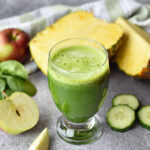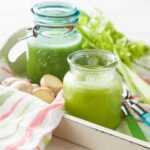Juice Tips and Tricks
How To Make Pineapple Juice With The Skin

Making homemade fruit juices is a hobby I enjoy, with pineapple juice being a favorite. Apart from its delicious flavor, it offers numerous health benefits such as boosting the immune system, improving digestion, and reducing inflammation. One of my go-to variations is pineapple ginger juice, which adds a zesty kick while enhancing its health-boosting properties. For those wondering how to prepare pineapple ginger juice, the process is simple: blend fresh pineapple chunks with a small piece of ginger and strain the mixture to enjoy a refreshing and revitalizing drink. This combination not only tastes amazing but also provides added benefits like increased metabolism and improved circulation.
But did you know that you can make pineapple juice with the skin? Yes, you read that right – you can use the skin of the pineapple to make a refreshing and nutritious juice. Using the skin of the pineapple is important because it contains a high concentration of bromelain, a digestive enzyme that helps break down proteins and aids in digestion.
Plus, the skin is also rich in antioxidants and other nutrients that are beneficial to our health. In this article, I’ll be sharing with you my step-by-step process for making pineapple juice with the skin, so you can enjoy all of its amazing benefits.
Key Takeaways
- Choosing the right pineapple is important to ensure maximum nutritional benefits.
- Cleaning and preparing a pineapple involves removing any dirt, debris, or pesticides from the skin.
- Blending the leftover pineapple skin creates a flavorful and nutritious juice, which can be paired with different foods or garnished creatively for added flavor and visual appeal.
- Adding water or other ingredients like apples, ginger, or spinach can create flavor variations and boost the nutritional value of the juice. Straining the mixture creates a smooth and pulp-free juice that’s ready to drink.
Benefits of Pineapple Juice
Let’s explore the amazing benefits of pineapple juice, shall we? Pineapple juice is a rich source of vitamins, minerals, and enzymes that provide significant nutritional value. It contains high levels of vitamin C, which is essential for healthy skin, the immune system, and wound healing.
Pineapple juice also contains vitamin B6, which supports the nervous system and helps to maintain healthy brain function. In addition to its nutritional value, pineapple juice offers numerous health benefits.
It has anti-inflammatory properties that can help to reduce pain and swelling, making it an ideal drink for people with arthritis or other inflammatory conditions. Pineapple juice also contains bromelain, an enzyme that aids in digestion by breaking down proteins. This enzyme has been shown to reduce bloating, constipation, and other digestive issues.
With all these benefits in mind, it’s easy to see why pineapple juice is a great addition to any healthy diet. Now, let’s talk about the importance of using the skin to make this juice.
Importance of Using the Skin
Using the skin of a pineapple is crucial to extracting its full nutritional value. Pineapple skin is rich in antioxidants, fiber, and enzymes, all essential for good health.
Antioxidants protect the body against harmful free radicals, fiber promotes good digestion, and enzymes play a vital role in breaking down food and absorbing nutrients.
Using the skin of a pineapple also has a sustainability aspect. It reduces food waste and makes the most of available resources. Instead of throwing away the skin, we can use it to make delicious and healthy juice, which benefits both our bodies and the planet.
Choosing the right pineapple is important to ensure we get the most out of its nutritional benefits.
Choosing the Right Pineapple
Picking the perfect pineapple is like finding a treasure, as the sweetest and most nutritious fruit lies within its rough exterior. When choosing a pineapple, it’s important to consider its ripeness.
A good indicator is the color of the leaves. If they’re green and healthy-looking, it means the pineapple is fresh and ripe. However, if the leaves are brown or wilted, the pineapple may be overripe and not as sweet.
Another factor to consider is the quality of the pineapple. When looking at the skin, make sure there are no bruising or soft spots. A good pineapple should have a firm texture and a uniform color.
It’s also important to give the pineapple a sniff. A ripe pineapple should have a sweet aroma. With these simple tips, you’ll be able to pick out the perfect pineapple for making your delicious pineapple juice.
When you’ve selected the perfect pineapple, the next step is to clean and prepare it.
Cleaning and Preparing the Pineapple
Once you have chosen the ideal pineapple, it is essential to properly clean and prepare it for consumption. The cleaning process involves removing any dirt, debris, or pesticides that may be on the pineapple’s skin. To do this, you will need a few tools.
Firstly, you will need a clean cutting board and a sharp knife. I recommend using a serrated knife, as it will make it easier to cut through the tough skin of the pineapple. You will also need a vegetable peeler to remove any remaining skin or blemishes. Lastly, a clean cloth or paper towel will come in handy for drying the pineapple after cleaning.
To further illustrate the cleaning process, here is a table that breaks it down into five simple steps:
| Step | Action |
|---|---|
| 1 | Rinse the pineapple under running water |
| 2 | Cut off the top and bottom of the pineapple |
| 3 | Stand the pineapple upright on the cutting board |
| 4 | Use the vegetable peeler to remove any remaining skin or blemishes |
| 5 | Dry the pineapple with a clean cloth or paper towel |
Now that the pineapple is cleaned and prepped, it’s time to move on to the next step: cutting the pineapple and separating the skin.
Cutting the Pineapple and Separating the Skin
Don’t let the tough exterior intimidate you – with the right technique, cutting and separating the skin of a pineapple can be a breeze.
First, I suggest using a sharp chef’s knife to cut off the top and bottom of the pineapple. Then, slice off the skin in sections, following the natural curve of the fruit. As you do this, you’ll notice that the skin is much thicker than the flesh, so take your time and be careful not to waste any of the sweet fruit.
Once you’ve separated the skin from the flesh, don’t throw it away! Using pineapple skin creatively can add a ton of flavor and nutrients to your juice. Some people choose to use the skin as a garnish, while others chop it up and toss it into the blender.
Keeping the skin intact also has its benefits – it contains a high amount of bromelain, an enzyme that aids in digestion and can reduce inflammation in the body. With all these benefits, it’s definitely worth the extra effort to keep the skin intact.
Now, let’s move onto blending the pineapple skin to create a delicious and healthy juice.
Blending the Pineapple Skin
Get ready to be amazed by how delicious and nutritious this blended concoction can be – simply toss the leftover pineapple skin into the blender and watch as it transforms into a flavorful elixir. Don’t be fooled by the rough exterior of the skin – it’s packed with nutrients such as bromelain, vitamin C, and antioxidants.
The taste profile is slightly bitter and tangy, but can easily be balanced out with the addition of other ingredients. When blending the pineapple skin, it’s important to cut it into smaller pieces to ensure it blends evenly. I recommend blending it on high speed for about 1-2 minutes until it reaches a smooth consistency.
The nutritional value of the skin is not to be underestimated – studies have shown that it can help with digestion, reduce inflammation, and even boost immunity. To take this pineapple juice to the next level, try adding water or other ingredients to dilute or enhance the flavor.
But first, let’s talk about the importance of using a high-quality blender for the best results.
Adding Water or Other Ingredients
To enhance the flavor and nutritional benefits of pineapple skin juice, you can add water or other ingredients to the mixture. Adding water makes the juice less concentrated and more refreshing, while adding other fruits and vegetables like carrots or cucumbers can create flavor variations and boost the nutritional value of the juice.
Water is the simplest ingredient you can add to the pineapple skin juice. You can add as much water as you want, depending on your preference. For a more flavorful and nutritious juice, try adding other ingredients like apples, ginger, or spinach. These ingredients not only add extra flavor to the juice but also provide additional vitamins and minerals.
Once you have added the desired ingredients, you can proceed to the next step of straining the juice.
Straining the Juice
Now that you’ve added water and other ingredients, it’s time to strain the mixture to create a smooth and pulp-free juice that’s ready to drink. To achieve the desired juice consistency, I recommend using a fine mesh strainer or cheesecloth.
Here are some tips to help you get the most juice out of your pineapple skin:
- Hold the strainer over a large bowl and pour the mixture through the strainer slowly. This’ll help to separate the juice from any remaining pulp or bits of skin.
- Use a spoon to press down on the pulp and extract as much juice as possible. Be sure to scrape the bottom of the strainer to get all the juice out.
- If you’re using cheesecloth, gather the corners and squeeze out the juice. This may take a bit more effort, but it’ll result in a smoother juice.
- If you prefer a thicker juice, you can skip the straining step altogether and simply blend the mixture until smooth.
Now that your pineapple juice is strained and ready to go, it’s time to serve and enjoy!
Serving and Enjoying Pineapple Juice with Skin
When it’s ready, you’ll love how refreshing and delicious drinking this pineapple skin juice can be. Once you’ve strained the juice, it’s time to serve it up and enjoy it. One way to make it even more enjoyable is to get creative with garnishing. I like to add a slice of fresh pineapple or a sprig of mint to my glass for an extra pop of flavor and visual appeal. You could also try rimming your glass with sugar or coconut flakes for a tropical touch.
Another way to take your pineapple skin juice to the next level is to pair it with different foods. It’s a great drink to enjoy on its own, but it also pairs well with certain dishes. For example, a glass of pineapple juice with skin would be the perfect accompaniment to a plate of grilled shrimp or fish tacos. You could even use it as the base for a tropical cocktail. The possibilities are endless, so don’t be afraid to get creative and experiment with different flavors.
Speaking of getting creative, there are plenty of other uses for pineapple skin besides making juice. Let’s explore some of those in the next section.
Other Uses for Pineapple Skin
You’re missing out on a world of possibilities if you toss away pineapple skins without realizing their potential for adding flavor and nutrition to your meals. Pineapple skins are not only edible but can also be used for various purposes.
Here are some of the uses for pineapple skins that you may find interesting:
-
DIY skincare: Pineapple skins contain bromelain, an enzyme that has anti-inflammatory and exfoliating properties. You can use the skin as a natural exfoliant by rubbing it on your skin or making a face mask by blending the skin with honey or yogurt. Pineapple skin can also be used to treat acne and reduce dark spots.
-
Culinary uses: Pineapple skins can be used to infuse flavor in various dishes. You can use them to make a broth for soups or stews, or add them to your tea for a tropical twist. Pineapple skin can also be used to ferment vegetables or make vinegar.
Don’t underestimate the power of pineapple skins. They can be a great addition to your beauty routine and elevate your culinary creations. So next time you’re cutting a pineapple, make sure to keep the skin and explore its many uses.
Frequently Asked Questions
Can I use canned pineapple instead of fresh pineapple?
Yes, canned pineapple is a viable alternative to fresh pineapple for making juice. However, fresh pineapple contains more nutritional benefits, such as higher amounts of vitamin C and digestive enzymes.
How long does pineapple juice with skin last in the fridge?
Storing pineapple juice with skin can be tricky, but I’ve found that it can last up to 3 days in an airtight container in the fridge. Don’t throw away the skin, use it to infuse water or make a delicious marinade for meats.
Is it safe to consume pineapple juice with skin if I have allergies?
As someone with allergies, I would caution against consuming pineapple juice with skin. The skin may contain allergens that could trigger a reaction. However, it’s important to note that the skin also contains valuable nutritional benefits.
Can I use a juicer instead of a blender to make pineapple juice with skin?
Oh sure, because who needs a blender when you can just toss a whole pineapple into a juicer, skin and all? But seriously, while a blender may be better for extracting the skin’s benefits, a juicer can still work. Just make sure to remove any tough parts first.
What are some potential side effects of consuming pineapple juice with skin?
Skin consumption safety is important when consuming pineapple juice with skin. Potential side effects include digestive discomfort, mouth sores, and skin irritation. However, the skin provides additional nutritional benefits such as fiber and vitamin C.
Conclusion
In conclusion, making pineapple juice with the skin is a great way to reap all the benefits that this tropical fruit has to offer. Not only does it add a unique flavor, but the skin also contains valuable nutrients that are often discarded.
With the right preparation and a few simple steps, you can easily make a delicious and healthy drink that’s perfect for any occasion. As I sipped on my freshly made pineapple juice with skin, I couldn’t help but feel a sense of satisfaction knowing that I’d utilized every part of the fruit.
The tangy sweetness of the juice was a perfect complement to the warm sun beating down on me. It was like I was transported to a tropical paradise with each sip. So next time you have a pineapple, don’t throw away the skin. Instead, use it to make a refreshing and nutritious drink that’ll leave you feeling satisfied and refreshed.
Susannah expertise lies in researching and compiling evidence-based content on juicing, nutrition, and overall health. She is committed to ensuring that The Juicery World offers accurate, up-to-date, and trustworthy information to empower readers to take control of their health. Susannah’s goal is to inspire individuals to embrace juicing as a way to nourish their bodies and live their best lives.
Juice Tips and Tricks
How to Make Aloe Vera Juice Taste Better

Tired of the strong flavor of aloe vera juice? No problem, we’ve got the answer for you.
In this article, we’ll share some tips and tricks to make your aloe vera juice taste better. We have tried and tested various methods to enhance the flavor without compromising the health benefits.
From choosing the right juice to adding natural sweeteners and infusing with fruits and herbs, we’ve got all the information you need to transform your aloe vera juice into a delightful and refreshing beverage.
Let’s dive in!
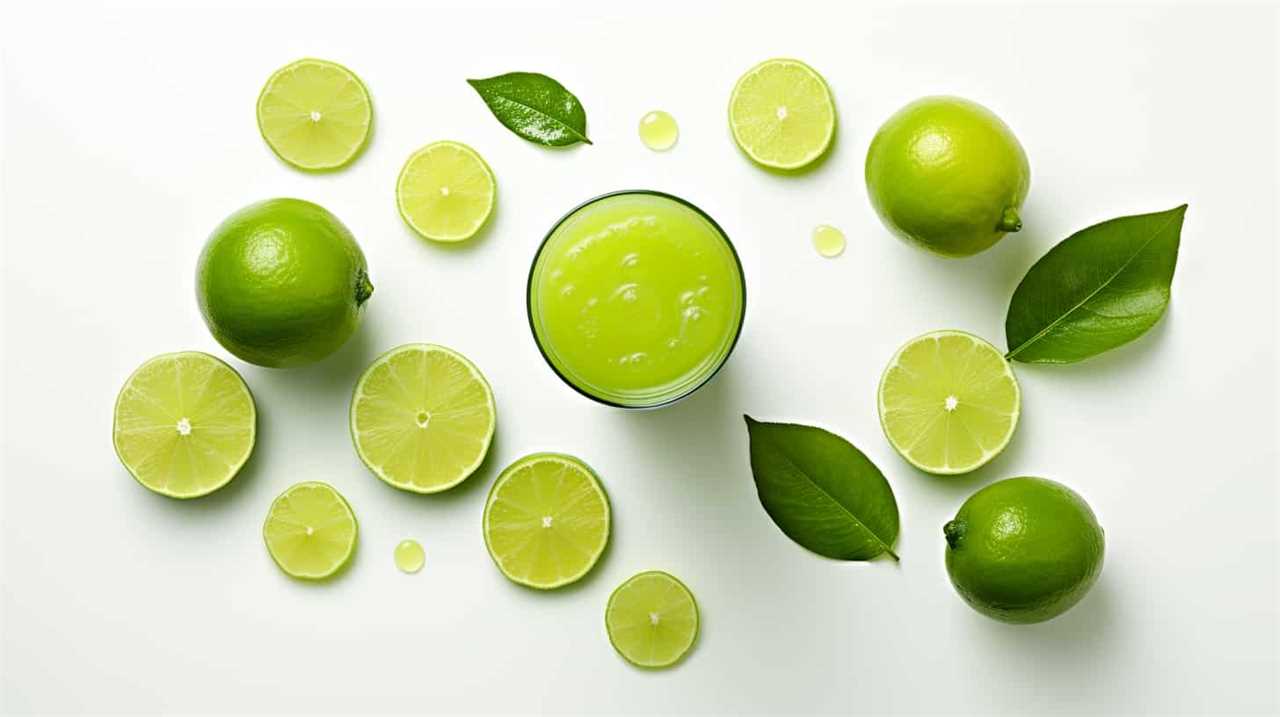
Key Takeaways
- Choose a reputable brand of aloe vera juice that prioritizes quality and uses organic, pure aloe vera.
- Avoid brands that contain added sugars or artificial ingredients.
- Use natural sweeteners like honey, agave syrup, or stevia to enhance the taste of aloe vera juice.
- Experiment with adding fruits, herbs, and other juices to create unique flavor combinations and enhance the health benefits of aloe vera juice.
Choosing the Right Aloe Vera Juice
We can enhance our experience with aloe vera juice by selecting the right brand and type for our preferences. When it comes to finding a reputable brand, it’s important to do some research and read reviews from other consumers. Look for brands that prioritize quality and use organic, pure aloe vera without any added sugars or artificial ingredients. Understanding the health benefits of aloe vera juice is also crucial in making the right choice. Aloe vera is known for its soothing properties, aiding digestion, promoting skin health, and boosting the immune system. By choosing a high-quality brand, we can ensure that we’re getting the maximum benefits from our aloe vera juice.
Now that we know how to choose the right brand, let’s move on to the next step of adding natural sweeteners.
Adding Natural Sweeteners
To enhance the flavor of our aloe vera juice, we can add natural sweeteners such as honey or agave syrup. Using alternative sweeteners not only adds sweetness but also brings unique flavors to the juice. Here are some options to consider:
- Stevia: A natural sweetener derived from the Stevia plant, it’s a zero-calorie alternative to sugar.
- Maple Syrup: This natural sweetener adds a rich and earthy flavor to the aloe vera juice.
- Dates: Pureed dates can be used to sweeten the juice while also providing essential nutrients like fiber.
In addition to using alternative sweeteners, we can enhance the flavor of aloe vera juice by adding spices and extracts. Cinnamon, ginger, or vanilla extract can add warmth and depth to the taste. By experimenting with different combinations of these natural sweeteners, spices, and extracts, we can create a flavor profile that suits our preferences.

Now, let’s move on to the next section and learn how to infuse aloe vera juice with fruits and herbs to further enhance its taste.
Infusing With Fruits and Herbs
As we explore ways to make our aloe vera juice taste better, one option to consider is infusing it with fruits and herbs. Creating unique aloe vera blends by adding fruits and herbs not only enhances the flavor but also adds a touch of freshness and complexity to the juice. For example, combining aloe vera juice with lemon, mint, or berries can create a refreshing drink that’s both delicious and packed with additional nutrients. It’s similar to the ease of making lemonade with bottled juice—quick, convenient, and customizable to suit your preferences. By experimenting with different fruit and herb combinations, you can elevate your aloe vera juice experience while still reaping its health benefits.
Fruits like strawberries, pineapple, or citrus can add a burst of sweetness, while herbs like mint, basil, or ginger can provide a subtle yet refreshing twist. Exploring the benefits of herbal infusions can also be beneficial for our health. For example, adding a few sprigs of lavender can promote relaxation and reduce stress. Additionally, infusing aloe vera juice with rosemary can aid digestion and boost the immune system.
Blending With Other Juices
Let’s try mixing aloe vera juice with different fruit juices to create delicious and refreshing blends. Blending aloe vera juice with other fruits not only enhances its taste but also adds nutritional benefits to your drink. Here are three fruit juices that you can mix with aloe vera juice:

- Orange juice: Combining aloe vera juice with orange juice not only adds a tangy flavor but also boosts your intake of vitamin C, which is essential for a strong immune system.
- Pineapple juice: Mixing aloe vera juice with pineapple juice creates a tropical blend that isn’t only refreshing but also helps in digestion. Pineapple contains bromelain, an enzyme that aids in breaking down proteins and promoting better digestion.
- Watermelon juice: Blending aloe vera juice with watermelon juice creates a hydrating and refreshing combination. Watermelon is rich in water content and contains electrolytes that can help replenish your body’s fluids.
Experimenting With Flavor Combinations
While we can try various flavor combinations with aloe vera juice, it’s important to find the right balance to enhance its taste. Experimenting with different flavors can’t only make the juice more enjoyable but also enhance its health benefits.
Aloe vera juice is known for its numerous health benefits, such as boosting digestion, promoting hydration, and supporting the immune system. By adding complementary flavors, we can create a refreshing summer drink that not only tastes great but also provides a nutritional boost.
Some popular flavor combinations include mixing aloe vera juice with citrus fruits like lemon or orange, adding a splash of coconut water for a tropical twist, or combining it with cucumber and mint for a refreshing and cooling effect.
Don’t be afraid to get creative and find the flavor combination that suits your taste buds best!

Frequently Asked Questions
Can I Use Store-Bought Aloe Vera Gel Instead of Fresh Aloe Vera for Making Juice?
Yes, you can use store-bought aloe vera gel instead of fresh aloe vera for making juice. However, it’s important to note that fresh aloe vera juice may have more health benefits due to its higher nutrient content.
How Long Can I Store Aloe Vera Juice in the Refrigerator?
Aloe vera juice can be stored in the refrigerator for up to a week. Refrigeration helps maintain the longevity and freshness of the juice, preserving its beneficial properties. It’s important to store the juice in an airtight container to prevent contamination and maintain its quality. Similarly, you might wonder *how long ginger juice lasts*; typically, fresh ginger juice can be refrigerated for about 1–2 weeks as well. Both aloe vera and ginger juices are best consumed within their shelf life to ensure maximum potency and health benefits. Additionally, freezing either juice can extend their shelf life, though some loss of nutrients and potency may occur during the process. When thinking about *how long fresh juice lasts*, it’s crucial to check for signs of spoilage, such as changes in smell, taste, or color, before consuming. To enjoy the best results, it’s always recommended to use fresh ingredients and properly store the juice to ensure you’re getting the most out of its health benefits.
Can Aloe Vera Juice Help With Digestive Issues?
Aloe vera juice can potentially help with digestive issues when taken in appropriate dosages. However, it is important to note that there may be potential side effects. It is always best to consult with a healthcare professional before starting any new supplement regimen.
Can I Use Artificial Sweeteners Instead of Natural Sweeteners in My Aloe Vera Juice?
Using artificial sweeteners in aloe vera juice may affect its taste and potential health benefits. However, natural sweeteners like honey or stevia can enhance the flavor without compromising its nutritional value.

Is It Safe to Drink Aloe Vera Juice Every Day?
Drinking aloe vera juice daily can have numerous benefits, such as improving digestion and boosting the immune system. However, consuming it regularly may also lead to potential side effects like diarrhea or stomach cramps.
Conclusion
In conclusion, making aloe vera juice taste better is easy and enjoyable.
By choosing the right aloe vera juice and adding natural sweeteners, infusing with fruits and herbs, blending with other juices, and experimenting with flavor combinations, you can create a delightful and refreshing drink.
So go ahead and unleash your creativity in the kitchen, and transform your aloe vera juice into a sensational elixir that will transport your taste buds to paradise.
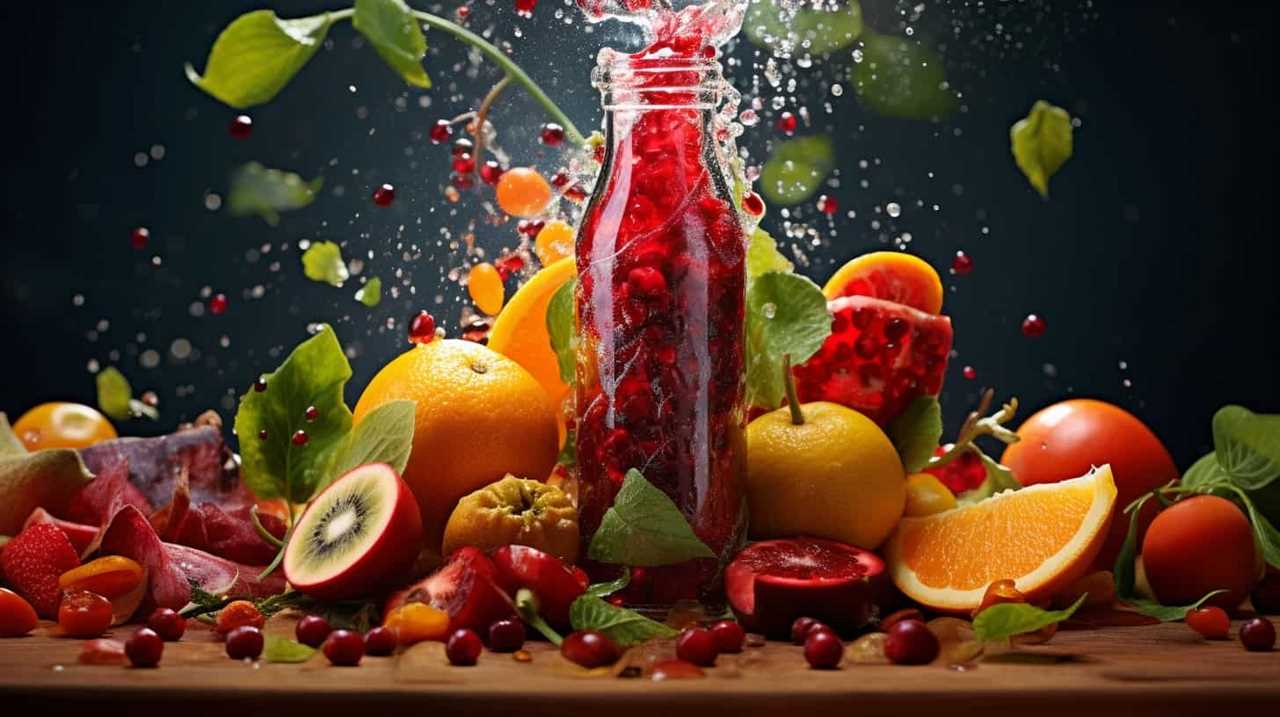
Susannah expertise lies in researching and compiling evidence-based content on juicing, nutrition, and overall health. She is committed to ensuring that The Juicery World offers accurate, up-to-date, and trustworthy information to empower readers to take control of their health. Susannah’s goal is to inspire individuals to embrace juicing as a way to nourish their bodies and live their best lives.
Juice Tips and Tricks
How to Make a Glass of Lemonade With Bottled Lemon Juice

Are you craving a cool glass of lemonade to quench your thirst? Look no further! Try out our perfect recipe using bottled lemon juice that will surely please your taste buds.
In this article, we’ll guide you through the process of creating a tangy and sweet concoction that will leave you feeling refreshed and satisfied.
So grab your ingredients and let’s get started on this delightful journey of serving ourselves and others a glass of pure lemony goodness.
Key Takeaways
- Consider the storage of the bottled lemon juice (dark glass or plastic bottles, protect from light exposure, check expiration date)
- Choose a suitable pitcher and fresh lemons for enhanced flavor
- Store the lemonade concentrate in the refrigerator to maintain freshness
- Adjust the sweetness and tartness to taste with sugar or more lemon juice, and experiment with different sweeteners or additional flavors.
Choosing the Right Bottled Lemon Juice
What are the key factors we should consider when selecting the right bottled lemon juice for our lemonade?

One important factor is how the lemon juice is stored. Look for bottles that are made of dark glass or plastic, as they help protect the juice from light exposure, which can degrade its quality. It’s also important to check the expiration date to ensure freshness.
Another benefit of using bottled lemon juice is convenience. It saves time and effort compared to squeezing fresh lemons. Additionally, bottled lemon juice provides consistent flavor, as the acidity levels are standardized.
When selecting a brand, consider reading reviews and checking for certifications, such as organic or non-GMO.
Gathering the Necessary Ingredients and Tools
How can we gather all the necessary ingredients and tools to make a glass of lemonade with bottled lemon juice? First, we’ll need to collect bottled lemon juice, sugar, and cold water, as well as a pitcher and a spoon for mixing. If you prefer extra flavor, you can also gather ice and optional add-ins like mint or soda water. While preparing the lemonade, it’s easy to understand why some people wonder about other citrus drinks and may ask, “how many oranges per gallon” are needed when making orange juice instead. Once everything is assembled, combine the lemon juice, sugar, and water in the pitcher, stirring until the sugar dissolves. Feel free to adjust the sweetness or tartness to your liking, and don’t forget to add ice or any optional add-ins for an extra refreshing touch. This process might even make you curious about how much juice from oranges is needed when making fresh orange juice compared to using bottled citrus products. Once your lemonade is ready, pour it into a glass and enjoy the refreshing taste. This simple recipe can inspire you to try other homemade juices, such as learning **how to make pear juice** or experimenting with other fruit combinations. Whether you’re using fresh fruits or bottled options, creating your own beverages is a fun and rewarding way to personalize your drinks.
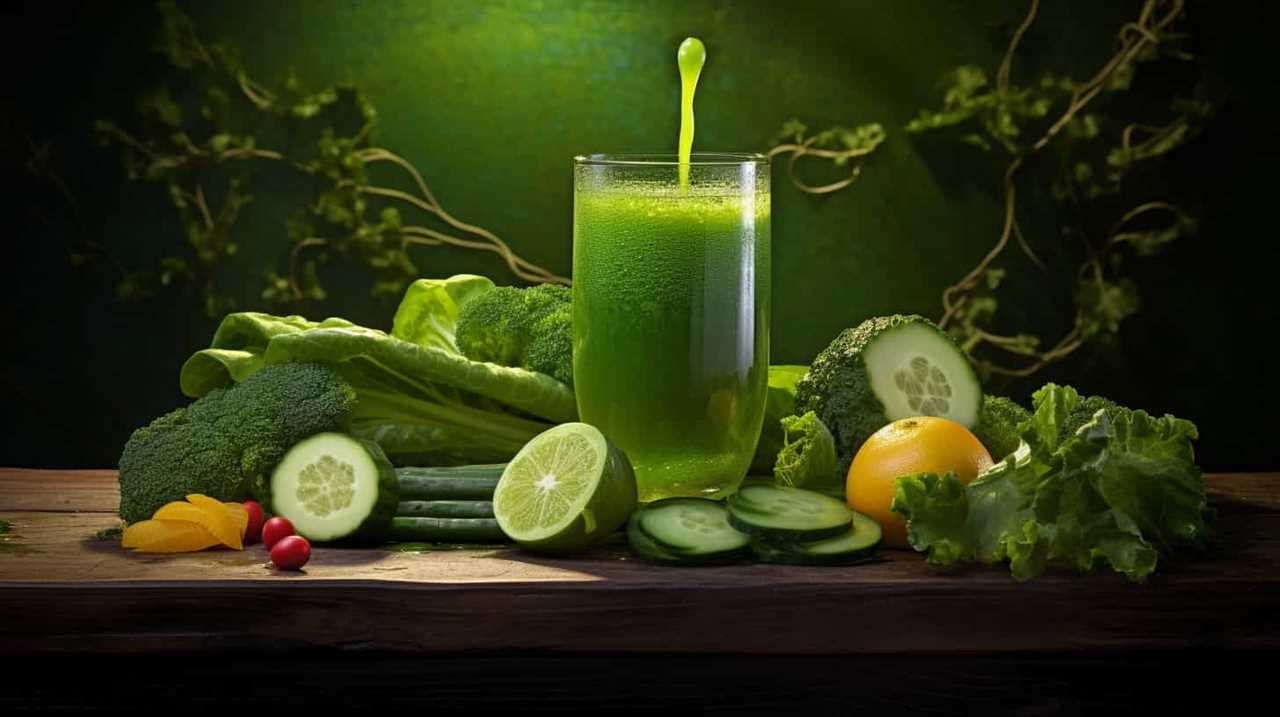
It’s important to start with the right pitcher. Look for a pitcher that’s made of glass or BPA-free plastic, as these materials won’t affect the taste of the lemonade. The pitcher should also have a lid or cover to keep the lemonade fresh and prevent spills.
Now, let’s talk about the lemons. While bottled lemon juice is convenient, using fresh lemons instead can elevate the flavor of your lemonade. Choose lemons that are firm and have a bright yellow color. Give them a gentle squeeze to ensure they’re juicy. To extract the juice, you’ll need a citrus juicer or a reamer. These tools make it easy to get every last drop of juice from the lemons.
Mixing the Lemonade Concentrate
To start mixing the lemonade concentrate, we’ll slowly pour the bottled lemon juice into the pitcher. It’s important to choose the right container for the lemonade concentrate. A pitcher with a lid or a tightly sealed container will help maintain the freshness and prevent any spills or leaks. Once the lemon juice is in the pitcher, we can move on to the next step of adding water and sweetener.
To ensure the lemonade concentrate stays fresh, it’s essential to store it properly. Keep the pitcher in the refrigerator to maintain its cool temperature and prevent any bacteria growth. If you have any leftover concentrate, transfer it to a smaller container with an airtight lid before refrigerating. This will help retain its flavor and prevent any contamination.

Now that we’ve mixed the lemonade concentrate, it’s time to adjust the sweetness and tartness to taste.
Adjusting the Sweetness and Tartness to Taste
We can adjust the sweetness and tartness of the lemonade to taste by adding more sugar or lemon juice, respectively. If you prefer a sweeter lemonade, simply add more sugar and stir until it dissolves completely. You can experiment with different sweeteners such as honey or agave syrup to find the perfect balance of sweetness.
On the other hand, if you want a tangier lemonade, add more lemon juice gradually, tasting as you go until it reaches your desired level of tartness.
Additionally, you can get creative with your lemonade by adding flavors like fresh mint leaves or a hint of lavender. These additions can elevate the flavor profile and create a more refreshing and unique experience.

Now that we’ve adjusted the sweetness and tartness of our lemonade, let’s move on to serving and enjoying your refreshing glass of lemonade.
Serving and Enjoying Your Refreshing Glass of Lemonade
Now let’s sit back, relax, and savor our refreshing glass of lemonade.
When it comes to serving and enjoying this delightful drink, there are a few techniques and garnishing options to consider.
Firstly, serving your lemonade chilled is essential for maximum enjoyment. Ensure that you have chilled glasses or add ice cubes to the glasses before pouring the lemonade.

To add a touch of elegance, you can garnish your lemonade with a slice of lemon on the rim of the glass. For an extra burst of flavor, you could also add a sprig of fresh mint or a few berries.
Remember to gently stir the lemonade before serving to evenly distribute the flavors.
Now, take a sip, feel the refreshing tang of lemon, and let the sweet and tart flavors dance on your taste buds.
Cheers!

Frequently Asked Questions
Can I Use Fresh Lemons Instead of Bottled Lemon Juice?
Fresh lemons offer numerous benefits over bottled lemon juice. The taste of fresh lemons is unparalleled, providing a vibrant and tangy flavor. Incorporating fresh lemons into your lemonade will elevate its taste and give it a refreshing and authentic twist.
Can I Substitute Sugar With a Different Sweetener?
Substituting sweeteners in lemonade can enhance the flavor and offer health benefits. We’re knowledgeable about alternative sweeteners and can provide precise, detailed instructions on using them in place of sugar.
How Long Does the Lemonade Concentrate Need to Chill in the Refrigerator?
The chilling time for the lemonade concentrate in the refrigerator is typically around 1-2 hours. Using bottled lemon juice offers the benefit of convenience and consistent flavor for a refreshing glass of lemonade.
Can I Add Other Fruits or Flavors to the Lemonade?
Sure, we can definitely add different fruits or flavors to our lemonade. It’s a great way to experiment with unique flavors and create refreshing, personalized drinks. The possibilities are endless!

How Long Does the Lemonade Stay Fresh in the Refrigerator?
Lemonade made with bottled lemon juice can stay fresh in the refrigerator for about 5-7 days. To maximize shelf life, store it in an airtight container and keep it chilled.
Conclusion
And so, with a few simple steps and the right ingredients, a glass of refreshing lemonade is born.
Like a symphony of flavors dancing on your taste buds, this tangy elixir quenches thirst and brings joy on a hot summer day.
Just a sip transports you to a world of citrusy delight, where the sweetness and tartness blend harmoniously.

So go ahead, indulge in the art of lemonade-making and savor every drop of this sun-kissed nectar.
Cheers to the perfect glass of lemonade!
Susannah expertise lies in researching and compiling evidence-based content on juicing, nutrition, and overall health. She is committed to ensuring that The Juicery World offers accurate, up-to-date, and trustworthy information to empower readers to take control of their health. Susannah’s goal is to inspire individuals to embrace juicing as a way to nourish their bodies and live their best lives.
Juice Tips and Tricks
How to Know if Orange Juice Is Bad

We’ve all been in that situation before – reaching for a glass of orange juice and hesitating, unsure if it’s still okay to drink. Fear not! This article will give you the knowledge you need to determine for sure if your orange juice is still fresh or if it’s gone bad.
With a blend of scientific precision and practical tips, we’ll explore color changes, strange smells, off taste, texture changes, and mold or growth that may indicate spoilage.
Let’s dive in and serve ourselves a refreshing glass of certainty!
Key Takeaways
- Color changes in orange juice can indicate a loss of freshness and shelf life extension, but it doesn’t necessarily mean the juice is bad.
- Unusual or off-putting odors in orange juice, such as sour or fermented scents, can be a sign of poor quality.
- An off taste in orange juice, such as sour, bitter, or fermented flavors, suggests that the juice is spoiled.
- Texture changes in orange juice, such as pulp separation or a thicker consistency, can occur as the juice ages, so it’s important to consume it before the expiration date.
Color Changes in Orange Juice
We should be aware that color changes can indicate whether orange juice is bad.

When it comes to orange juice, color is a crucial factor to consider. As oranges are exposed to air, an oxidation process occurs, which leads to changes in color. Fresh orange juice has a vibrant orange hue, indicating its freshness and high nutritional value.
However, as time passes, the juice may undergo a color change, turning dull or brownish. This change in color is a result of the oxidation process, which affects the flavor and quality of the juice. It’s important to note that while a change in color doesn’t necessarily mean the juice is bad, it does indicate that the juice is losing its freshness and shelf life extension.
Therefore, it’s advisable to consume orange juice when it’s at its freshest, as indicated by its vibrant orange color.
Strange Smells in Orange Juice
When it comes to evaluating orange juice, we should be cautious of any strange smells or odors. A fresh, pleasant smell is indicative of good quality orange juice. However, if you notice any unusual or off-putting odors, it may be a sign that the juice has gone bad. These smells can range from a sour or fermented scent to a rancid or moldy aroma.

It’s important to note that while some natural variations in scent can occur due to the specific variety of oranges used, any strong or unpleasant smells should raise concerns. If you have citrus fruit allergies, it’s especially important to pay attention to the smell of orange juice, as it could indicate the presence of spoilage or contamination.
Ensuring the quality of orange juice is essential as it’s a popular beverage known for its health benefits, including being rich in vitamin C and antioxidants.
Off Taste of Orange Juice
Our taste buds can detect even the slightest hint of an off taste in orange juice, which can indicate that it has gone bad. The taste of orange juice should be fresh, tangy, and slightly sweet. If it tastes sour, bitter, or fermented, it’s likely spoiled.
One common cause of an off taste in orange juice is the use of overripe oranges. When oranges become overripe, their flavor profile changes, resulting in a less pleasant taste. Another factor to consider is the expiration date. Orange juice that has passed its expiration date is more likely to develop an off taste. It’s important to check the expiration date before consuming orange juice to ensure its freshness and quality. Additionally, improper storage conditions, such as leaving the juice at room temperature for extended periods, can lead to the development of unpleasant flavors. Storing orange juice in the refrigerator helps maintain its freshness for longer. For those exploring different juice options, aloe vera juice flavor tips suggest pairing tart juices with milder flavors to balance the overall taste.
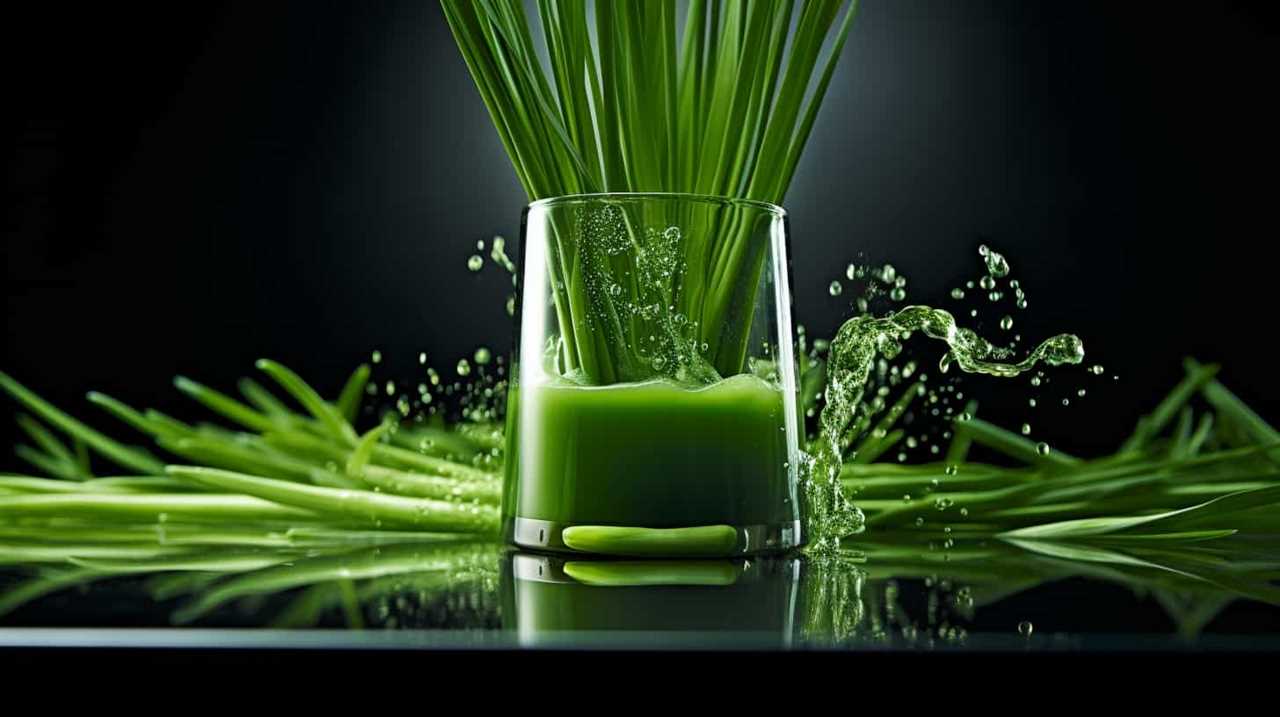
Now, let’s move on to discuss the texture changes in orange juice.
Texture Changes in Orange Juice
As we explore the texture changes in orange juice, it’s important to note that certain factors can cause it to become thicker or develop sediment. One common texture change in orange juice is pulp separation, where the pulp separates from the liquid and settles at the bottom. This can occur naturally over time, as the pulp particles become denser and sink.
Another factor that can affect the texture of orange juice is the expiration date. As orange juice ages, it may start to develop a thicker consistency and even form sediment. This is a result of the natural breakdown of the juice’s components. Therefore, it’s crucial to check the expiration date on orange juice and consume it before it reaches its expiration date to avoid any undesirable texture changes.
Mold or Growth in Orange Juice
We need to be aware of the possibility of mold or other growth occurring in orange juice. Mold can develop in orange juice if it isn’t stored properly or if it has passed its expiration date.

To prevent mold growth, it’s important to follow these steps:
- Store orange juice in the refrigerator at a temperature below 40°F (4°C).
- Check the expiration date on the bottle before consuming. Discard any orange juice that has expired.
- Keep the container tightly sealed to prevent air and moisture from entering, as these can promote mold growth.
Regularly inspecting orange juice for any signs of mold or unusual growth is essential. If you notice any discoloration, a strange odor, or visible mold, it’s best to discard the juice to avoid any potential health risks.
Frequently Asked Questions
Can Orange Juice Go Bad if It’s Stored in the Freezer for Too Long?
Frozen orange juice can potentially lose its nutrients and change its taste if stored in the freezer for too long. It is important to check for signs of spoilage before consuming it.
How Long Can Orange Juice Stay Fresh in the Refrigerator Once It’s Opened?
Once opened, orange juice can stay fresh in the refrigerator for about 7-10 days. To maintain its freshness, store it properly by keeping it tightly sealed and at a consistently cold temperature. If the orange juice develops an off odor, flavor, or appearance, it’s best to discard it to avoid any potential health risks. Factors like exposure to air and varying temperatures can influence how long orange juice lasts, so it’s crucial to handle it with care. Always check the expiration date as a general guide, but remember that proper storage can extend its freshness slightly. Additionally, avoid leaving the orange juice out at room temperature for extended periods, as this can significantly shorten how long orange juice lasts. Freezing the juice can be another option to extend its shelf life, but be aware that this may alter its texture and taste once thawed. By following these precautions, you can ensure your orange juice stays fresh and safe to consume.
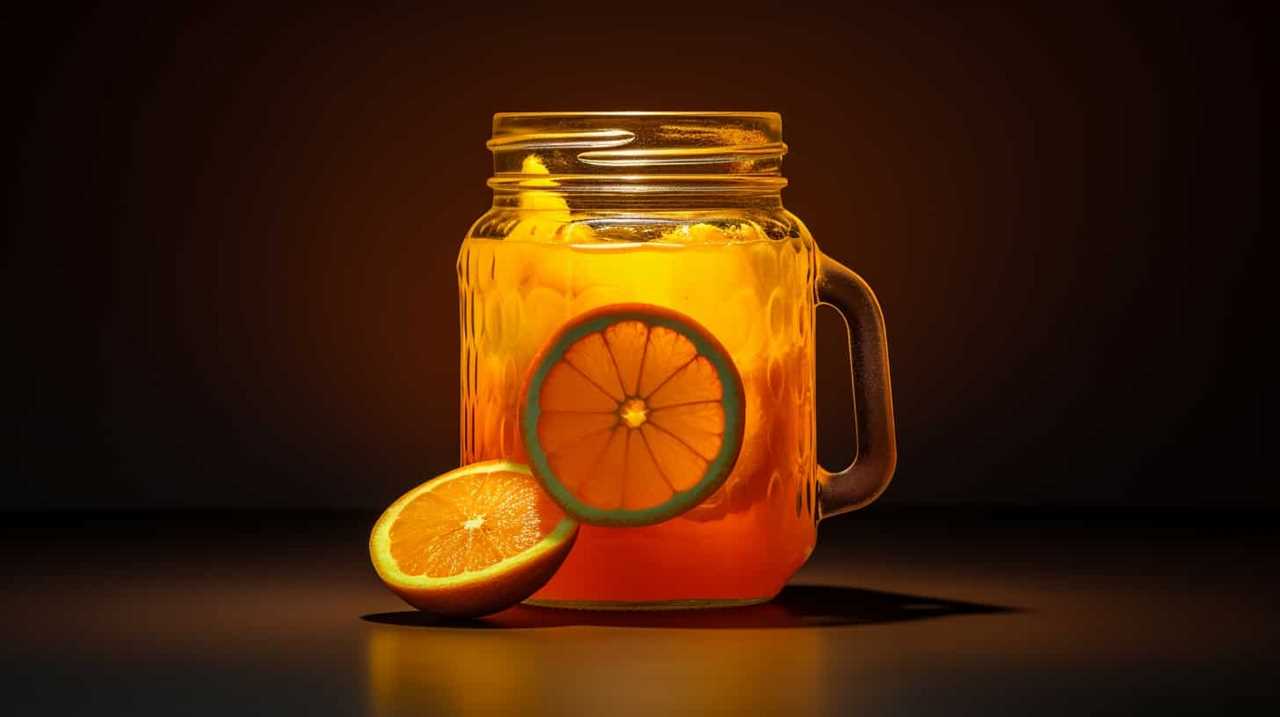
Is It Safe to Consume Orange Juice That Has Been Left Out at Room Temperature Overnight?
Left out orange juice may not be safe to drink as it can harbor harmful bacteria. Signs of spoiled orange juice include a sour smell, mold growth, and a change in color or taste.
Can Orange Juice Develop Harmful Bacteria if It’s Past Its Expiration Date but Still Looks and Smells Fine?
Orange juice can cause food poisoning if it develops harmful bacteria, even if it looks and smells fine. Signs of spoiled orange juice include a sour smell, mold growth, and a change in color or taste.
Does the Nutritional Value of Orange Juice Decrease as It Starts to Go Bad?
As orange juice goes bad, its nutritional value decreases. The longer it sits on the shelf, the more nutrients it loses. Signs of spoilage include a sour smell, off taste, and mold growth.
Conclusion
In conclusion, determining if orange juice is bad requires careful observation of color changes, strange smells, off taste, and texture changes. Just like a detective investigating a case, we must rely on our senses to detect any signs of spoilage.
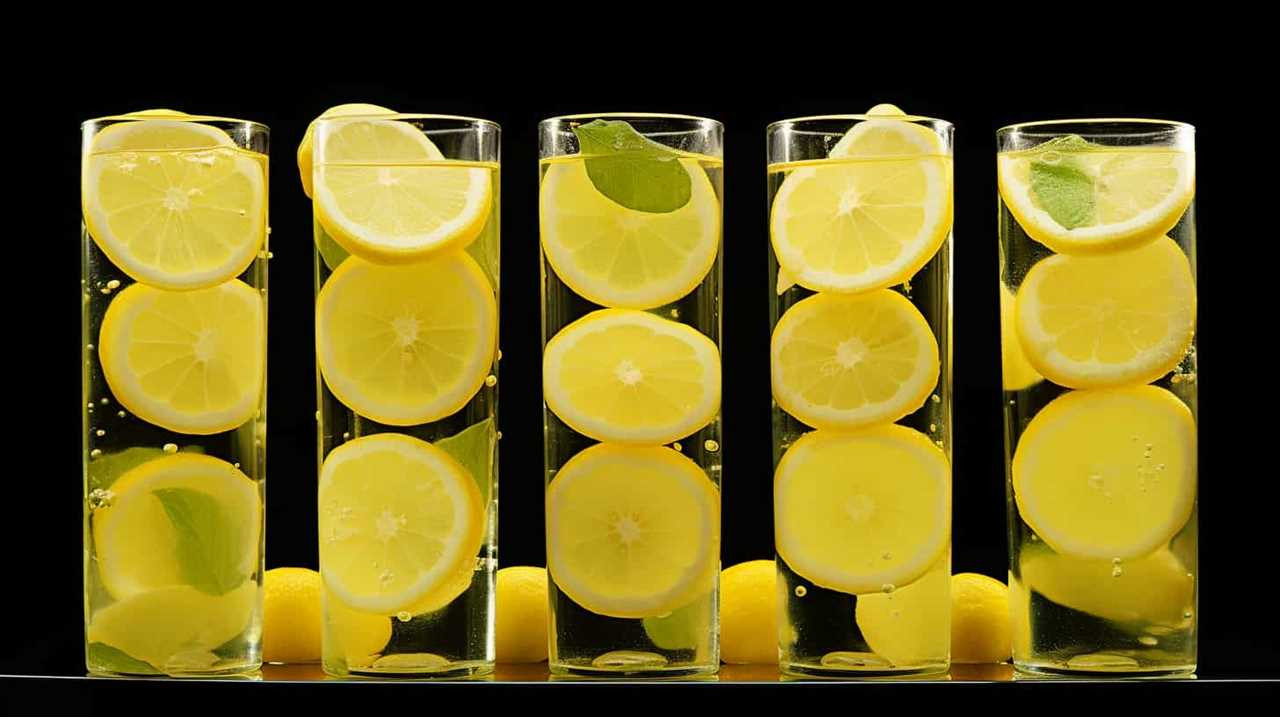
If we detect mold or growth in the orange juice, it’s a clear indication that it’s no longer safe to consume. By remaining vigilant and attuned to these indicators, we can ensure that our orange juice is always fresh and enjoyable.
Susannah expertise lies in researching and compiling evidence-based content on juicing, nutrition, and overall health. She is committed to ensuring that The Juicery World offers accurate, up-to-date, and trustworthy information to empower readers to take control of their health. Susannah’s goal is to inspire individuals to embrace juicing as a way to nourish their bodies and live their best lives.
-

 Vetted2 months ago
Vetted2 months ago15 Best Juices for Diabetics: Refreshing Options That Won’t Spike Your Blood Sugar
-

 Vetted2 months ago
Vetted2 months ago15 Best Decaf Coffee Options for Flavor Lovers Who Need a Caffeine Break
-

 Vetted2 months ago
Vetted2 months ago15 Best Espresso Ground Coffees to Elevate Your Morning Brew
-

 Vetted2 months ago
Vetted2 months ago15 Best K-Cup Coffee Pods for a Perfect Brew Every Time
-

 Vetted2 months ago
Vetted2 months ago15 Best Beans for Espresso: A Guide to Perfecting Your Brew
-

 Vetted2 months ago
Vetted2 months ago15 Best Kona Coffees to Savor the Rich Flavors of Hawaii
-

 Vetted2 months ago
Vetted2 months ago15 Best Inexpensive Espresso Machines That Brew Quality Coffee on a Budget
-

 Vetted2 months ago
Vetted2 months ago15 Best Cold Brew Coffees to Keep You Refreshed All Summer Long





